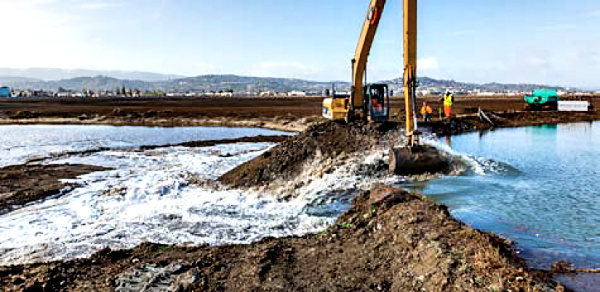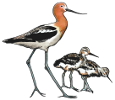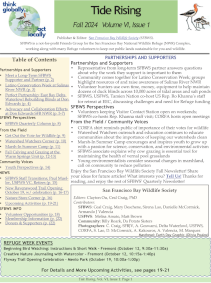Levee Breach Celebrates Wetland Restoration on San Francisco Bay
by Doug Cordell, Public Affairs Officer, U.S. Fish & Wildlife Service
As the morning skies cleared of threatening clouds at a December 10, 2015 ceremony in Redwood City, CA, a hundredplus guests cheered a levee breach that reintroduced tidal water to inner Bair Island on the Don Edwards San Francisco Bay National Wildlife Refuge for the first time since the area was diked off for agriculture in the 1880s.

A levee breach at the Dec. 10 event caps a multi-year restoration that will return the diked-off site to tidal wetlands. Photo courtesy U.S. FWS / Julie Kitzenberger.
The breach culminates a $7.5 million restoration project overseen by the U.S. Fish & Wildlife Service that will enable the 1500-acre site, the largest undeveloped island in South San Francisco Bay, to grow back into to the marshland it was 150 years ago.
“This project is a key piece of the puzzle in restoring the lost wetlands around the Bay,” said Anne Morkill, manager of the San Francisco Bay National Wildlife Refuge Complex, which hosted the event. Morkill cited the benefits wetlands provide not only for wildlife, but in terms of water quality, reduction of flood risk, and expanded opportunities for public recreation.

Anne Morkill, San Francisco Bay National Wildlife Refuge Complex manager, addresses guests at Dec. 10 Bair Island restoration celebration near Redwood City, Calif. Photo courtesy U.S. FWS / Julie Kitzenberger.
The Bair Island project notably incorporates a number of public access features, including a pedestrian footbridge onto the site, a newly restored trail and interpretive displays. In addition, volunteers planted native plants to provide habitat for endangered species like the California Ridgway’s rail and the salt marsh harvest mouse.
Represented among the speakers at the Dec. 10 event were key partners of the Service on the restoration project, the Peninsula Open Space Trust, which helped fund the acquisition of the property, and Ducks Unlimited, the contractor on the ambitious effort. California Department of Fish and Wildlife, which manages Middle and Outer Bair Island, was also on hand to celebrate.
Perhaps most important, however, was the participation of representatives from two citizen-activist groups, the Friends of Redwood City and the Citizens Committee to Complete the Refuge, that fought a valiant, decades-long and ultimately successful battle to save the site from development.
Bair Island got its name in the 1920s from Fred Bair, who owned a home and raised cattle on the land. In the 1940s, the Leslie Salt company acquired the property and built levees for salt-making that divided it into three sections: Outer, Middle and Inner Bair Island. In 1973 the land was again sold, to Mobil Oil, which began a large-scale development plan for the area. In response, the Friends of Redwood City and the Citizens Committee to Complete the Refuge, together with organizations like the Audubon Society and Save the Bay, mobilized opposition. Eventually, they found a buyer for the land in the conservation community: the Peninsula Open Space Trust, which, in 1999, turned the three sections of the island over to the U.S. Fish & Wildlife Service and the CA Department of Fish and Wildlife.


